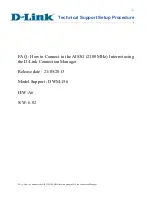
The transmission speed will never exceed the adapter base speed to any single address (per specification).
Teams can contain two to eight adapters, but must match the capability of the switch. Adapter teams
configured for Static Link Aggregation also provide the benefits of fault tolerance and load balancing.
NOTE:
You cannot use an Intel AMT enabled adapter in an SLA team
IEEE 802.3ad Dynamic Link Aggregation
802.3ad is an adopted IEEE standard. Teams can contain two to eight adapters, and you can have a
maximum of two IEEE 802.3ad dynamic teams per server. You must use 802.3ad switches (in dynamic
mode, aggregation can go across switches). Adapter teams configured for IEEE 802.3ad also provide the
benefits of fault tolerance and load balancing. Under 802.3ad, all protocols can be load balanced.
Dynamic mode supports multiple aggregators. Aggregators are formed by port speed connected to a switch.
For example, a team can contain adapters running at 1 Gbps and 10 Gbps, but two aggregators will be formed,
one for each speed. Also, if a team contains 1 Gbps ports connected to one switch, and a combination of
1Gbps and 10Gbps ports connected to a second switch, three aggregators would be formed. One containing
all the ports connected to the first switch, one containing the 1Gbps ports connected to the second switch,
and the third containing the 10Gbps ports connected to the second switch.
NOTES:
l
Once you choose an aggregator, it remains in force until all adapters in that aggregator lose
link.
l
In some switches, copper and fiber adapters cannot belong to the same aggregator in an
IEEE 802.3ad configuration. If there are copper and fiber adapters installed in a system,
the switch might configure the copper adapters in one aggregator and the fiber-based
adapters in another. If you experience this behavior, for best performance you should use
either copper
or
fiber-based adapters in a system.
l
If multiple switches are used, all team members connected to the same switch must oper-
ate at the same speed.
l
You cannot use an Intel AMT enabled adapter in a DLA team.
Before you begin
l
Verify that the switch fully supports the IEEE 802.3ad standard.
l
Check your switch documentation for port dependencies. Some switches require pairing to start on a
primary port.
l
Check your speed and duplex settings to ensure the adapter and switch are running at full duplex,
either forced or set to auto-negotiate. Both the adapter and the switch must have the same speed and
duplex configuration. The full duplex requirement is part of the IEEE 802.3ad specification:
If needed, change your speed or duplex setting
before
you link the adapter to the switch. Although you
can change speed and duplex settings after the team is created, Intel recommends you disconnect the
cables until settings are in effect. In some cases, switches or servers might not appropriately
recognize modified speed or duplex settings if settings are changed when there is an active link to the
network.
















































